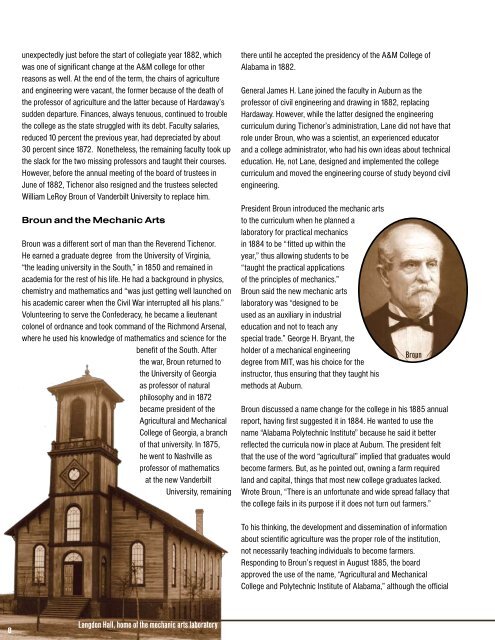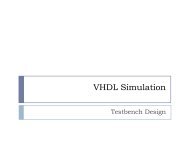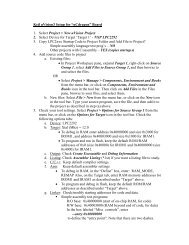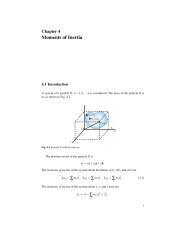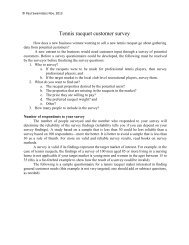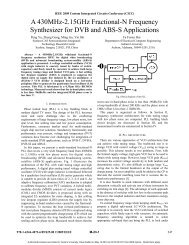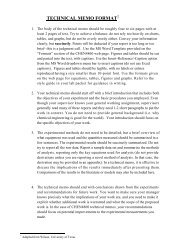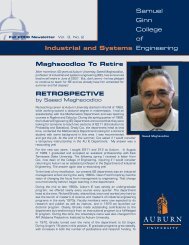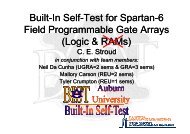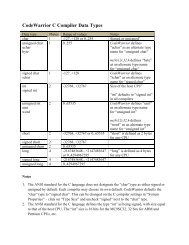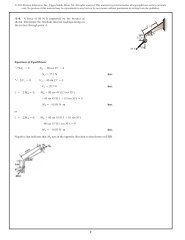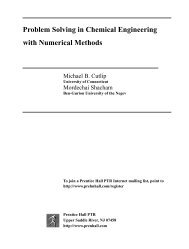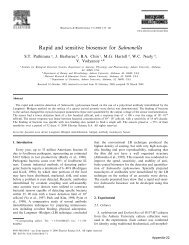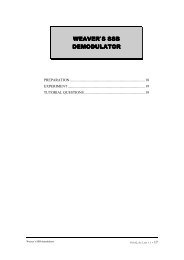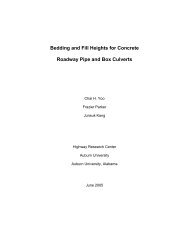Auburn Engineering alumni magazine fall/winter 09 - Samuel Ginn ...
Auburn Engineering alumni magazine fall/winter 09 - Samuel Ginn ...
Auburn Engineering alumni magazine fall/winter 09 - Samuel Ginn ...
Create successful ePaper yourself
Turn your PDF publications into a flip-book with our unique Google optimized e-Paper software.
8<br />
unexpectedly just before the start of collegiate year 1882, which<br />
was one of significant change at the A&M college for other<br />
reasons as well. At the end of the term, the chairs of agriculture<br />
and engineering were vacant, the former because of the death of<br />
the professor of agriculture and the latter because of Hardaway’s<br />
sudden departure. Finances, always tenuous, continued to trouble<br />
the college as the state struggled with its debt. Faculty salaries,<br />
reduced 10 percent the previous year, had depreciated by about<br />
30 percent since 1872. Nonetheless, the remaining faculty took up<br />
the slack for the two missing professors and taught their courses.<br />
However, before the annual meeting of the board of trustees in<br />
June of 1882, Tichenor also resigned and the trustees selected<br />
William LeRoy Broun of Vanderbilt University to replace him.<br />
Broun and the Mechanic Arts<br />
Broun was a different sort of man than the Reverend Tichenor.<br />
He earned a graduate degree from the University of Virginia,<br />
“the leading university in the South,” in 1850 and remained in<br />
academia for the rest of his life. He had a background in physics,<br />
chemistry and mathematics and “was just getting well launched on<br />
his academic career when the Civil War interrupted all his plans.”<br />
Volunteering to serve the Confederacy, he became a lieutenant<br />
colonel of ordnance and took command of the Richmond Arsenal,<br />
where he used his knowledge of mathematics and science for the<br />
benefit of the South. After<br />
the war, Broun returned to<br />
the University of Georgia<br />
as professor of natural<br />
philosophy and in 1872<br />
became president of the<br />
Agricultural and Mechanical<br />
College of Georgia, a branch<br />
of that university. In 1875,<br />
he went to Nashville as<br />
professor of mathematics<br />
at the new Vanderbilt<br />
University, remaining<br />
Langdon Hall, home of the mechanic arts laboratory<br />
there until he accepted the presidency of the A&M College of<br />
Alabama in 1882.<br />
General James H. Lane joined the faculty in <strong>Auburn</strong> as the<br />
professor of civil engineering and drawing in 1882, replacing<br />
Hardaway. However, while the latter designed the engineering<br />
curriculum during Tichenor’s administration, Lane did not have that<br />
role under Broun, who was a scientist, an experienced educator<br />
and a college administrator, who had his own ideas about technical<br />
education. He, not Lane, designed and implemented the college<br />
curriculum and moved the engineering course of study beyond civil<br />
engineering.<br />
President Broun introduced the mechanic arts<br />
to the curriculum when he planned a<br />
laboratory for practical mechanics<br />
in 1884 to be “fitted up within the<br />
year,” thus allowing students to be<br />
“taught the practical applications<br />
of the principles of mechanics.”<br />
Broun said the new mechanic arts<br />
laboratory was “designed to be<br />
used as an auxiliary in industrial<br />
education and not to teach any<br />
special trade.” George H. Bryant, the<br />
holder of a mechanical engineering<br />
degree from MIT, was his choice for the<br />
instructor, thus ensuring that they taught his<br />
methods at <strong>Auburn</strong>.<br />
Broun<br />
Broun discussed a name change for the college in his 1885 annual<br />
report, having first suggested it in 1884. He wanted to use the<br />
name “Alabama Polytechnic Institute” because he said it better<br />
reflected the curricula now in place at <strong>Auburn</strong>. The president felt<br />
that the use of the word “agricultural” implied that graduates would<br />
become farmers. But, as he pointed out, owning a farm required<br />
land and capital, things that most new college graduates lacked.<br />
Wrote Broun, “There is an unfortunate and wide spread <strong>fall</strong>acy that<br />
the college fails in its purpose if it does not turn out farmers.”<br />
To his thinking, the development and dissemination of information<br />
about scientific agriculture was the proper role of the institution,<br />
not necessarily teaching individuals to become farmers.<br />
Responding to Broun’s request in August 1885, the board<br />
approved the use of the name, “Agricultural and Mechanical<br />
College and Polytechnic Institute of Alabama,” although the official


